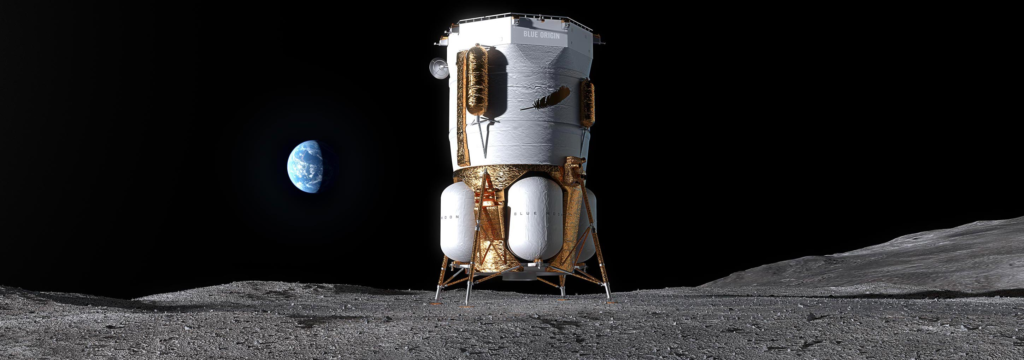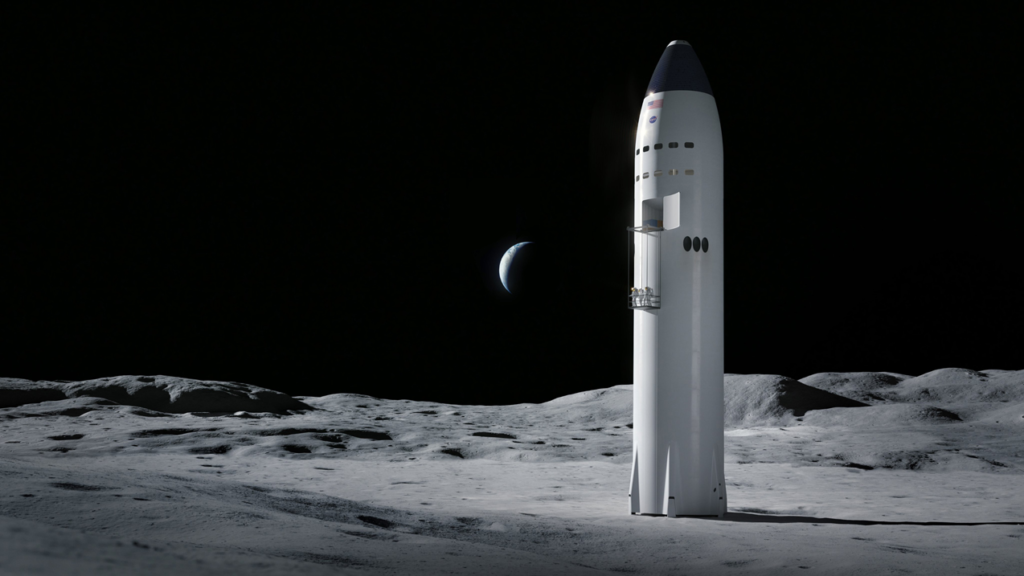
Blue Origin Just Revealed Its New Lunar Lander
Earlier this year we got a first look at Blue Origin’s new lunar lander designed to transport Artemis astronauts to the Moon’s surface and back to orbit. Just yesterday the company revealed a full physical lander demonstrator named Mk1.
In addition, Blue Origin gave out quite a bit more info including the plans for this initial lander, how it evolves into Mk2 which is made specifically for Artemis, its operations on the Moon, and even some of the mission goals. At the same time, we are also hearing more about SpaceX’s Starship lunar lander and timeline concerns in particular, which NASA brought up before.
The agency is now looking at both companies and options to determine what will be complete and by when. Here I will go more in-depth into Blue Origin’s lunar lander progress, NASA’s schedule concern for both SpaceX and Blue Origin, the future plan, and more.
Blue Origin’s Lunar Lander

Yesterday, Blue Origin tweeted saying, “We unveiled our nearly 3-story Blue Moon MK1 cargo lander demonstrator. MK1’s early missions will pave the way and prove technologies for our MK2 lander for @NASA’s Human Landing System.” This included an image of the large mock lander with Bezos and NASA administrator Bill Nelson, among other agency officials.
Besides just tweets, the company shared a bit more information on a new webpage. Here they are quoted saying, “Blue Moon Mark 1 (MK1) is a single-launch, lunar cargo lander that remains on the surface and provides safe, reliable, and affordable access to the lunar environment. MK1 will provide cargo transport, leveraging the 7-meter fairing of the New Glenn launch vehicle, to deliver up to three metric tons anywhere on the lunar surface.”
What these tweets and official statements highlight is that there will be two landers, Mk1 and Mk2. Mk1 will be available to payload customers and also serve as a core test unit without crew and payloads initially. Assuming missions go well and the system works as intended. Mk2 will be the lander actually responsible for carrying humans to the surface of the Moon and back apart of the Artemis missions. In regard to this, back in May, NASA selected Blue Origin to develop a lunar lander to transport astronauts on Artemis missions starting at the end of the decade. The value of the fixed-price award was $3.4 billion and the contract includes a demonstration landing on Artemis 5, currently scheduled for no earlier than late 2029, as well as an uncrewed test flight of the lander about one year earlier. This all matches up with what Blue Origin just revealed.
What’s interesting though is the idea that Mk1 will become available to the public similar to the CLPS or Commercial Lunar Payload Service contracts. In another statement Blue Origin says, “The Pathfinder Mission (MK1-SN001) will be a demonstration mission, with MK1-SN002 and beyond available to payload customers. This is very broad and could mean a bunch of different things. However, due to the large size of the mock lander, realistically in order for that type of service to be profitable the payloads being delivered would have to be a part of significant contracts. In other words, just carrying some small commercial payloads likely wouldn’t cut it. This could mean they are hoping for large future Artemis contracts to carry cargo and other supplies to the surface.
Recently, the senior vice president of lunar transportation at Blue Origin commented, “We’re building our landers, both our Mark 1 and our Mark 2, to enable global landing capability on the Moon, day or night,” The company also posted a statement saying, “MK1-SN001 proves out critical systems, including the BE-7 engine, cryogenic fluid power and propulsions systems, avionics, continuous downlink communications, and precision landing within 100 m site accuracy, prior to the uncrewed NASA Human Landing System mission for the Artemis program. With all things considered, Mark 1 seems to be a crucial stepping stone for the company before they start attempting missions with humans aboard.
In the future, these landers are intended to hitch a ride into space in New Glenn’s 7-meter fairing. MK1 will be capable of delivering three metric tons to any location on the Moon’s surface. That capacity would make it ideal for a variety of logistics, infrastructure, and science payloads. To add to everything, the landers are architected for that future day when lunar ice can be used to manufacture LOX and LH2 propellants on the Moon. That is Blue Origin’s long-term goal and plan with this lander infrastructure.
NASA’s Timeline Concerns

With future Artemis missions approaching including Artemis III, which is expected to land humans on the surface, the need for an operational lunar lander is becoming more important by the day. In the last few months, there has been a lot of talk regarding Blue Origin’s lunar lander and primarily SpaceX’s which needs to be ready first.
In a recent interview with Dr. Lisa Watson-Morgan, the manager of the Human Landing System (HLS) program operating at NASA’s Marshall Space Flight Center in Huntsville, Alabama, we got more information on the landers and the overall schedule. She mentioned that getting these landers ready for their debuts on the Artemis 3 and Artemis 5 mission respectively for SpaceX and Blue Origin provide both numerous challenges as well as unique opportunities. “I think we have great, great challenges in front of us,” she said. “Right now, today, I don’t see anything that’s stopping us, but that’s today.”
She went on to say, “That’s the beauty of our model. We take the best of what our government does, our expertise, and then we take a leap with the technological innovation from the industry. ‘We need to do this in order to save costs and make a business case out of this and give you the value and the good price that we are,’” Watson-Morgan said. “That’s where it’s such an engineering art in that we have to balance what they need to do to be successful from a business standpoint and ensure paramount, tantamount that we’re doing all we can for crew safety. And the crew is lock-and-step with us on both Blue and on SpaceX.”
As mentioned prior, there has been a lot of talk lately about SpaceX’s lunar lander and whether or not they will complete it in time. For example, a few months ago, speaking at a joint meeting of the National Academies’ Aeronautics and Space Engineering Board and Space Studies Board, Jim Free, NASA associate administrator for exploration systems development, said Artemis 3 was in danger of being delayed from December 2025 to some time in 2026. He went on to clarify that SpaceX and the Starship HLS system in particular was what he was worried about. Specifically, he pointed out the number of Starship launches that SpaceX has to carry out to be ready for Artemis 3. Each Starship lander mission requires launching the Starship lander itself as well as several “tanker” Starships to fuel the lander in Earth orbit before it goes to the moon.
“That’s a lot of launches to get those missions done,” Free said. “They have a significant number of launches to go, and that, of course, gives me concern about the December of 2025 date” for Artemis 3. He continued by saying, “With the difficulties that SpaceX has had, I think that’s really concerning. You can think about that slipping probably into ’26” he said.
On the other side, the interview with Watson Morgan seems to suggest that it is possible, however, there are some major challenges ahead. She noted her past experience as the deputy director of the Engineering Directorate at MSFC and more than 30 years as an engineer and manager leads her to “fully support and cherish” SpaceX’s approach to getting its lander ready. At the same time, she pointed out in a quote that “I would be remiss if I didn’t say we’re concerned about the SpaceX schedule for HLS and the concern is that our critical path, even today, goes through these test flights.”
“Schedule for us is key and we are working very closely with SpaceX on ensuring that this next test, making sure that they’re ready for it, understanding what they hope to achieve from it and understanding the risk. And they are all high risk,” Watson-Morgan said. She also mentioned in addition to the more highly visible flight test campaign, the HLS program and SpaceX have been stepping through some of the development milestones needed to support the version of Starship for the Artemis program.
When asked about Blue Origin, she commented that “her team is spending roughly equal time between the SpaceX and Blue Origin-led teams, which are working on similar, but different technology challenges. “We have one team that’s not too terribly big, but certainly big enough to go in and do deeper risk-based insight dives on things like propellant transfer, because both Blue Origin and SpaceX have that,” she said. “Different fuels and different architectures, but still, at the end of the day when you look at it, the cryo-fluid management is going to be key for both of them.”
She finished with one last quote highlighting, “We do it upfront so there are not questions or concerns or confusion as to how the system should be built in order for, later on, for our team to come in and be able to human-rate the system. So it’s super challenging. It’s super exciting. And all the time I get asked how do you sleep at night an I’m gonna tell you, I sleep very well because I take it one day at a time.”
Conclusion
Blue Origin just revealed its new Mk1 lunar lander along with some key information. This initial model will test the design and plans to land on the Moon with cargo before Mk2 is ready to land and transport humans. We will have to wait and see how it progresses and the impact it has on the space industry.
